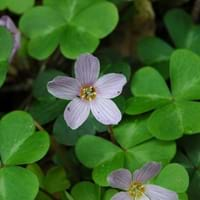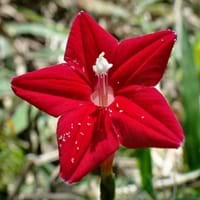Life Span
Perennial
Annual and Perennial
Type
Perennial
Bulb or Corm or Tuber
Origin
Western United States, Canada
South Africa
Types
not available
Not Available
Habitat
Moist woods, Redwood forests
Subtropical climates, subtropical regions
USDA Hardiness Zone
7-9
9-10
Sunset Zone
4, 5, 6, 7, 8, 9, 14, 15, 16, 17, 18, 19, 20, 21, 22, 23, 24
21,22
Habit
Spreading
Mat-forming
Flower Color
White, Purple, Pink, Lavender
Red, Magenta
Flower Color Modifier
Bicolor
Bicolor
Fruit Color
Not Available
Not Available
Leaf Color in Spring
Green
Gray Green
Leaf Color in Summer
Green
Light Green
Leaf Color in Fall
Green
Several shades of Green
Leaf Color in Winter
Light Green
Light Green
Leaf Shape
Heart-shaped
Long, Alternate
Plant Season
Spring, Summer, Fall, Winter
Spring, Summer
Sunlight
Partial Sun, Partial shade, Full Shade
Full Sun
Growth Rate
Very Fast
Medium
Type of Soil
Loam
Loam, Sand
The pH of Soil
Acidic, Neutral
Acidic, Neutral
Soil Drainage
Average
Well drained
Bloom Time
Early Spring, Spring, Late Spring, Early Summer, Summer, Late Summer, Early Fall, Fall
Late Spring, Early Summer, Summer
Tolerances
Drought
Drought
Where to Plant?
Container, Ground, Pot
Ground
How to Plant?
Divison, Seedlings
Seedlings
Plant Maintenance
Low
Medium
Watering Requirements
Average Water Needs, Medium
Needs good drainage, Needs high amount of water
In Summer
Ample Water
Lots of watering
In Spring
Adequately
Moderate
In Winter
Moderate
Average Water
Soil pH
Acidic, Neutral
Acidic, Neutral
Soil Type
Loam
Loam, Sand
Soil Drainage Capacity
Average
Well drained
Sun Exposure
Partial Sun, Partial shade, Full Shade
Full Sun
Pruning
Remove damaged leaves, Remove dead branches, Remove dead leaves
No pruning needed, Prune to control growth, Remove damaged leaves, Remove dead branches, Remove dead leaves
Fertilizers
All-Purpose Liquid Fertilizer
All-Purpose Liquid Fertilizer, High-phosphorous fertilizers used
Pests and Diseases
Red blotch
Pests and diseases free
Plant Tolerance
Drought
Drought
Flower Petal Number
Single
Single
Fragrant Flower
No
Not Available
Showy Foliage
No
Not Available
Foliage Texture
Medium
Fine
Foliage Sheen
Matte
Matte
Attracts
Not Available
Butterflies, Hummingbirds
Allergy
Not Available
Unknown
Aesthetic Uses
Ground Cover
Beautification, Ornamental use, Showy Purposes, small hedge
Beauty Benefits
Not Available
Not Available
Environmental Uses
Air purification, Provides ground cover
Air purification
Medicinal Uses
Antirheumatic, Boils, Opthalmic, Rheumatism, Sore Eyes, Swelling
Anti-fungal, Purgative
Part of Plant Used
Flowers, Leaves
Leaves
Other Uses
Culinary use, Employed in herbal medicine, Used As Food, Used for fragrance
Beneficial species for attracting pollinators
Used As Indoor Plant
No
No
Used As Outdoor Plant
Yes
Yes
Garden Design
Groundcover, Wildflower
Alpine, Container, Rock Garden / Wall, Tropical
Botanical Name
OXALIS oregana
Ipomoea quamoclit
Common Name
Redwood Sorrel
star glory , hummingbird vine
In Hindi
Redwood Sorrel
Kunjlata
In German
Redwood Sorrel
Ipomoea quamoclit
In French
Redwood Sorrel
Ipomoea quamoclit
In Spanish
Redwood alazán
Ipomoea quamoclit
In Greek
Redwood Sorrel
Ipomoea quamoclit
In Portuguese
Redwood Sorrel
Ipomoea quamoclit
In Polish
Redwood szczaw
Ipomoea quamoclit
In Latin
Rumex Redwood
Ipomoea quamoclit
Phylum
Magnoliophyta
Magnoliophyta
Class
Magnoliopsida
Magnoliopsida
Order
Geraniales
Solanales
Family
Oxalidaceae
Amaryllidaceae
Clade
Angiosperms, Eudicots, Rosids
Angiosperms, Asterids, Eudicots
Tribe
Not Available
Ipomoeeae
Subfamily
Not Available
Not Available
Number of Species
Not Available
Not Available
Season and Care of Redwood Sorrel and Cypress Vine
Season and care of Redwood Sorrel and Cypress Vine is important to know. While considering everything about Redwood Sorrel and Cypress Vine Care, growing season is an essential factor. Redwood Sorrel season is Spring, Summer, Fall and Winter and Cypress Vine season is Spring, Summer, Fall and Winter. The type of soil for Redwood Sorrel is Loam and for Cypress Vine is Loam, Sand while the PH of soil for Redwood Sorrel is Acidic, Neutral and for Cypress Vine is Acidic, Neutral.
Redwood Sorrel and Cypress Vine Physical Information
Redwood Sorrel and Cypress Vine physical information is very important for comparison. Redwood Sorrel height is 10.20 cm and width 30.00 cm whereas Cypress Vine height is 7.60 cm and width 7.60 cm. The color specification of Redwood Sorrel and Cypress Vine are as follows:
Redwood Sorrel flower color: White, Purple, Pink and Lavender
Redwood Sorrel leaf color: Green
Cypress Vine flower color: Red and Magenta
- Cypress Vine leaf color: Gray Green
Care of Redwood Sorrel and Cypress Vine
Care of Redwood Sorrel and Cypress Vine include pruning, fertilizers, watering etc. Redwood Sorrel pruning is done Remove damaged leaves, Remove dead branches and Remove dead leaves and Cypress Vine pruning is done No pruning needed, Prune to control growth, Remove damaged leaves, Remove dead branches and Remove dead leaves. In summer Redwood Sorrel needs Ample Water and in winter, it needs Moderate. Whereas, in summer Cypress Vine needs Lots of watering and in winter, it needs Average Water.





